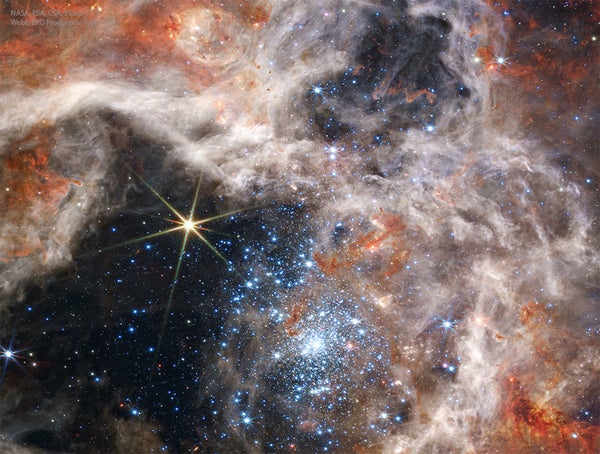When you look up into the night sky at a big, bright star, the familiar “twinkling” you see comes from the star’s light wriggling its way through Earth’s turbulent atmosphere. But if you could leap into hyperspace and visit that star directly, you might witness a twinkle of a different sort.
Much like the bubbling churn of boiling water on a stove top, hot material can swirl in and around the hearts of massive stars. And a new simulation from an international team of scientists shows how disturbances arising from these convective flows can subtly alter how stars shine.
“Waves inside a star are like the waves you see in the ocean. So if you throw a stone into water, you see it generate waves that’s moving away from where you threw the stone in,” says May Gade Pedersen, an astronomer at the University of Sydney.
On supporting science journalism
If you're enjoying this article, consider supporting our award-winning journalism by subscribing. By purchasing a subscription you are helping to ensure the future of impactful stories about the discoveries and ideas shaping our world today.
Convective flows within a star can act as this proverbial stone because heat always seeks to rise. On Earth, when you boil a pot of water, the liquid bubbles up, driven by heat rising from below. Similarly, in a star’s core, heat can push huge flows of plasma up and out to then crash into the core’s perimeter.
This titanic clash reverberates through the star in the form of so-called gravity waves. Not to be confused with gravitational waves, their distant astrophysical cousins, convection-powered gravity waves can readily erupt within a massive star’s tumultuous core, sparking global brightness-altering oscillations that impart a subtle “twinkle” all their own. Published in Nature Astronomy, the recent study’s simulation of stellar gravity waves demonstrates a new model for predicting just how much corresponding “twinkling” a star should do.
Astronomers have long struggled to study the shrouded cores of massive stars. Better understanding internal gravity waves could provide critical information about the stars they bounce around in, says study co-author Evan Anders.
“If we can measure those waves, we can use them to tell, really precisely, how big the core is, what part of the star’s life it’s at ... or how big of a black hole it’s going to leave behind,” says Anders, an astronomer at Northwestern University’s Center for Interdisciplinary Exploration and Research in Astrophysics. “It propagates through to everything else about big stars and what we’re trying to figure out there.”
Studying stars solely by their basic surface features—star spots, overall brightness, size—is rather like a doctor diagnosing a patient just by looking at them, says Yan-Fei Jiang, an astronomer at the Flatiron Institute in New York City, who was not involved in the study. A cursory visual examination won’t necessarily reveal what’s actually going on inside someone’s body—that’s what x-rays and magnetic resonance imaging machines are for. Astronomers use gravity waves in a similar manner: to probe the hidden depths of stars and understand their internal structure.
Empirically validating the study’s hypotheses will not be easy, but Anders says telescopes such as NASA’s Transiting Exoplanet Survey Satellite could provide useful observations. He also wants to test the model on smaller stars that can exhibit similar but weaker gravity waves in hopes of developing a more general method suitable for probing a wider range of stellar interiors. The next step, though, is to further flesh out the simulation to better model a massive star, even if there are always limitations.
“When we run these simulations, something has to give,” Anders says. “You can’t actually run a star.”
Gravity waves are not the only sources of stellar variability, however, and this study potentially settles a debate among astronomers about just how much such waves really contribute to the bigger picture of a star’s fluctuating brightness. In addition to these waves, surface-level tumult can also tweak a massive star’s shine. Some astronomers suspected that gravity waves produce this separate disturbance, too, but the study suggests the phenomena manifest at entirely different frequencies, meaning it is unlikely that gravity waves are the culprit.
Astronomers still aren’t sure what causes this more superficial effect. But distinguishing its effects from the impact of gravity waves could further refine their still-incomplete understanding of the structure and behavior of massive stars. Though the findings are still just from models, Pedersen is thrilled by the fact that a star’s twinkle can reveal so much.
“What I find really fascinating with astronomy is how much we can learn just from studying the light of stars,” she says. “Because that’s all we really have.”
